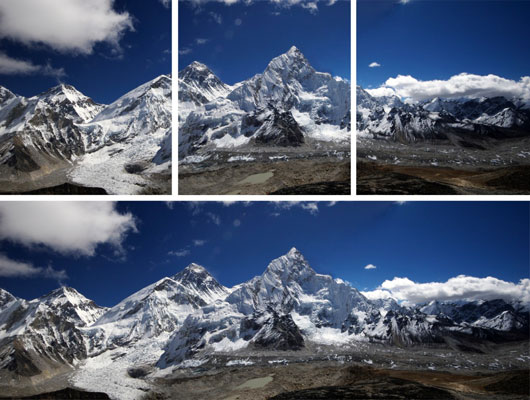

I will say that I’ve taken pictures with each of the methods from the photo below and have gotten decent results from each.

Pivoting at the lens aperture is considered ideal because of an issue called “parallax.” For a more in depth understanding of the problem you can read this article. This can affect the amount of distortion in your photos and cause the stitching program difficulty with matching up similar items.
#ADOBE PHOTOSHOP ELEMENTS 10 PANORAMA STITCHER FULL#
Batch Edit When Making Adjustments – I usually combine my photos and then make any color or exposure corrections to the full panorama.I want the whole scene, near and far, to be in focus. Use Aperture Priority Settings – I usually set a small aperture to ensure as much of the scene is in focus as possible.This difference becomes noticeable when the pictures are all combined (see the photo below for an example). However, if you’re transitioning through a range of lighting situations, your photos will vary in terms of brightness or color balance. In many circumstances, using automatic settings will work fine. The Pictures All Look the Same – You are creating one image from multiple photos, so make sure that all the photos look the same.Make sure that there’s a little padding so nothing important has to be cropped out. Through the editing process you’ll end up having to crop off areas at the top, bottom, left, and right to get a rectangular composition. You also want to leave extra room at the margins of your photos. By doing this you make sure that important elements won’t be out of frame at the top or bottom of your photo. The Whole Scene Fits – After you select your scene, you should look through your viewfinder and transition your camera through the whole range of the panorama before taking any photos.Make sure the tripod is level and that your camera doesn’t tilt as it moves across the scene. Tripod – A tripod can also help you transition your camera along a stable line.This can also be fixed later when cropping the image. Remember your rule of thirds, you probably don’t want the horizon running directly through the center of your photo. Use Natural Lines – If the scene offers you a straight line, the horizon for example, you can follow that or try to use it as a reference and keep the center of your frame a constant distance above or below that line.If they don’t, you will find yourself cutting out key elements of your photo when making the final crop. Your Photos Follow a Straight Line – The photos that make up your panorama need to follow a straight, horizontal (or vertical) line.There are A LOT of things you need to be simultaneously thinking about when taking your photos. Then, finally, I became wise to standard print sizes and started cropping my photos accordingly. I then started to take REALLY wide panoramas without concern for the final dimensions (see the 4.9 X 1 panorama below). It was a little while longer before I learned there are programs that will take multiple photos, match up the areas each photo has in common, and spit out a panorama a process known as panoramic stitching. I’d take a really wide-angle shot at, say, 11mm and then crop the photo so only a narrow band remained in the middle. My first attempts at panoramas were clumsy. 4 X 6 and 8 X 10 formats were great for most situations, but they didn’t convey the drama and size of landscapes or buildings as they existed in my mind. Even then, the photos didn’t look the way I imagined. So I did what any novice photographer would do, I bought more equipment specifically an 11-16mm lens. It didn’t take me long to realize that the wide-angle 18mm wasn’t wide enough for everything I wanted to do. When I got my first DSLR, I got an 18-200mm lens with it.


 0 kommentar(er)
0 kommentar(er)
